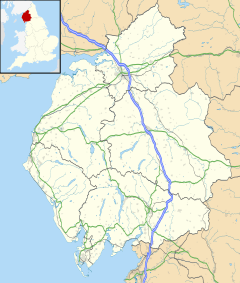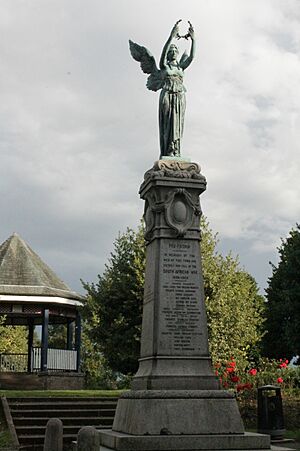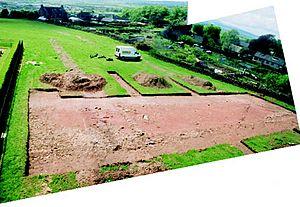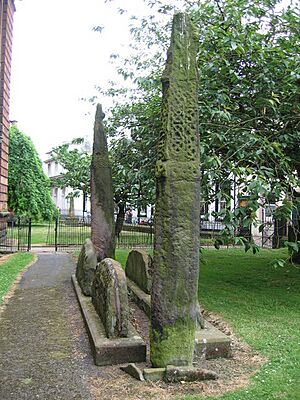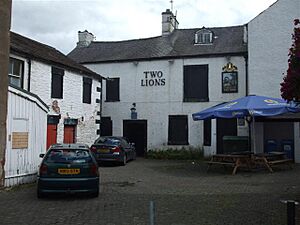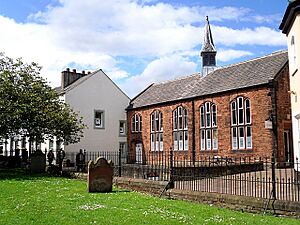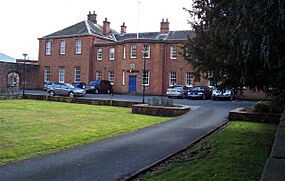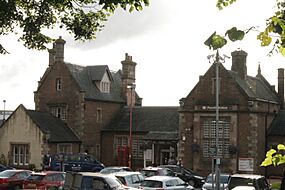Penrith, Cumbria facts for kids
Quick facts for kids Penrith |
|
|---|---|
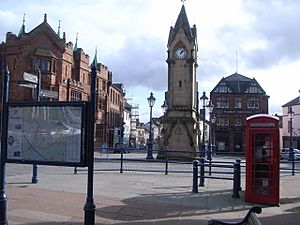 The Market Square |
|
 Flag |
|
| Population | 16,984 (2021 census) |
| Demonym | Penrithian |
| OS grid reference | NY515305 |
| Unitary authority |
|
| Ceremonial county | |
| Region | |
| Country | England |
| Sovereign state | United Kingdom |
| Post town | PENRITH |
| Postcode district | CA10, CA11 |
| Dialling code | 01768 |
| Police | Cumbria |
| Fire | Cumbria |
| Ambulance | North West |
| EU Parliament | North West England |
| UK Parliament |
|
Penrith is a lively market town and civil parish located in the Westmorland and Furness area of Cumbria, England. It's very close to the beautiful Lake District National Park, less than 3 kilometres away. The town is about 17 miles (27 km) south of Carlisle. Penrith sits between the Rivers Petteril and Eamont, and just north of the River Lowther. In 2021, about 16,984 people lived here. Historically, Penrith was part of Cumberland.
From 1974 to 2015, Penrith did not have its own local council. However, a new civil parish was created on April 1, 2015, and the first Penrith Town Council election happened on May 7, 2015. Before 2023, the town was part of the Eden District.
Contents
What Does the Name Penrith Mean?
The name "Penrith" has been discussed a lot. Some experts think it comes from the old Cumbric or Welsh words "pen" (meaning "head" or "end") and "rid" or "rhyd" (meaning "ford"). This could mean "chief ford" or "headland by the ford."
However, the center of Penrith is about 1 mile (1.6 km) from the closest river crossing at Eamont Bridge. Another idea for the name is "pen" (head, end, top) combined with a word like Welsh "rhudd" (meaning "crimson" or "red"). This "red hill" might refer to Beacon Hill, which is to the northeast of the town today. There are also other places nearby called Redhills and Penruddock. These names likely refer to the local red sandstone, which is very common in the area and was used to build many of Penrith's buildings.
Penrith's Ancient History
The story of Penrith goes back a very long time. Archaeologists have found signs of people living in this area continuously for thousands of years.
Stone Age and Bronze Age Life
Around 4500 BCE (Stone Age) to 1000 BCE (Bronze Age), important sites like Mayburgh Henge, King Arthur's Round Table, and Long Meg and Her Daughters were built near Penrith. These are some of the most significant ancient ritual sites in the region. Many old tools like stone axes, hammers, and knives have also been found.
Iron Age Tribes
During the British Iron Age (around 800 BCE to 100 CE), the area near Penrith was likely home to the Carvetti tribe. A large ancient enclosure found at Clifton Dykes suggests this. Penrith's location was important for travel and trade routes running north-south and east-west.
Romans in the Area
The Romans did not build Penrith itself, but they knew how important its location was. They built forts nearby, like Brougham (called Brocavum) and Plumpton (called Voreda), which is about five miles north of modern Penrith. These forts were connected by Roman roads, including one that went north to Carlisle.
Around these Roman forts, civilian settlements called vici grew up. Farmers, traders, and others lived there to support the soldiers. Evidence shows that people lived in this area continuously through the Roman period and even after the Romans left.
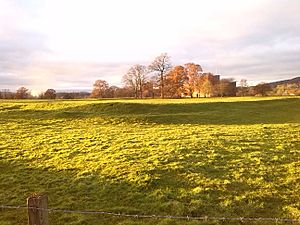
Penrith's Story Through Time
Penrith's history is largely shaped by its important location on major travel routes. This was especially true when England and Scotland often fought.
Early Medieval Times
After the Romans left around 450 CE, the north of Britain was divided into small Celtic kingdoms. One of these might have been Rheged, possibly centered in the Eden Valley.
- Angles and Vikings Arrive: In the 7th century, the Angles, a Germanic tribe, moved into the region. They gave names to settlements ending in "-ham" (like Askham) and "-ton" (like Barton). From about 870 CE, Vikings from Dublin and Yorkshire also settled here. They named places ending in "-by" (like Lazonby) and "-thorpe" (like Melkinthorpe).

- Viking Treasures: The Penrith Hoard of Viking silver brooches was found in the Eden Valley, near Penrith.
- Giant's Grave: In St. Andrew's churchyard, there are old stone carvings known as the "Giant's Grave" and "Giant's Thumb." These are a mix of Christian and Norse (Viking) designs and are thought to be from around the 920s.
- Meeting of Kings: On July 12, 927, a very important meeting took place near Penrith, possibly at Eamont Bridge. Athelstan, the King of the Anglo-Saxons, met with other kings from Britain, including the King of Scots and the King of the Cumbrians. This meeting is often seen as a key moment in the founding of the Kingdom of England. Penrith was under Scottish control until the Normans took over in 1092.
Later Medieval Times: Normans and Castles
- Norman Takeover: In 1092, William Rufus and the Normans took control of northern Cumbria, including Penrith. Penrith became a royal possession, meaning it belonged to the King or Queen.
- Market Town Growth: In 1223, King Henry III allowed Penrith to hold a market and a fair, which helped the town grow and earn money.
- Scottish Raids: Penrith suffered a lot during the Wars of Scottish Independence. Scottish forces attacked and destroyed parts of the town many times between 1296 and 1345.

- Building Penrith Castle: After the raids, a protective wall was built around the town. Later, Ralph Neville, 1st Earl of Westmorland, started building Penrith Castle. His son continued the work. The castle was more like a grand home than just a military fort. Richard of Gloucester, who later became King Richard III, used Penrith Castle as a base when he was fighting the Scots.
Early Modern Times: Tudors and Stuarts
- Tudor Changes: During the Tudor period, Penrith saw big changes like the English Reformation, which led to the closing of the Augustinian Priory. Penrith Grammar School was founded in 1564, helping to educate the town's youth.
- Plague Strikes: Penrith faced serious challenges, including a terrible outbreak of the Bubonic plague in 1597–1598, which caused many deaths.
- Stuart Period and Civil War: In Stuart times, Penrith was affected by national events like the English Civil War. Most of the local gentry supported the King.
- Penrith's Role in the War: During the war, Penrith became a supply center for Parliament. Later, both Brougham Castle and Penrith Castle were important strategic points. After the war, the town's economy continued to rely on raising cattle, making leather goods, and shoemaking.
How Penrith is Governed Today
UK Parliament
Penrith is part of the parliamentary constituency called Penrith and Solway. The person who represents Penrith in the UK Parliament is called a Member of Parliament (MP). Since 2024, the MP for Penrith and Solway is Markus Campbell-Savours from the Labour Party.
See also
 In Spanish: Penrith (Inglaterra) para niños
In Spanish: Penrith (Inglaterra) para niños


